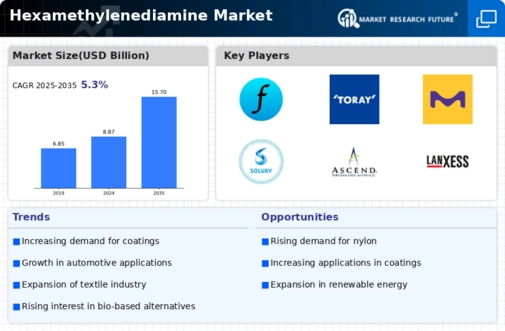-
Executive Summary
-
Market Introduction
-
2.1
-
Market Definition
-
Scope of the
- Research
- Assumptions & Limitations
-
Study
-
Objectives
-
Markets Structure
-
Key Takeaways
-
Market Research Methodology
-
3.1
-
Research Process
-
Primary Research
-
Secondary Research
-
3.4
-
Market Size Estimation
-
Forecast Model
-
Market Dynamics of the Global Hexamethylenediamine
-
Market
-
Introduction
-
Drivers
-
Restraints
-
Opportunities
-
4.5
-
Challenges
-
Trends/Technology
-
Market Factor Analysis of the
-
Global Hexamethylenediamine Market
-
Supply
- Raw Material Suppliers
- Manufacturers/Producers
- Distributors/Retailers/Wholesalers/E-Commerce
-
Chain Analysis
-
5.1.4
-
End User
-
Porter’s
- Threat of New
- Bargaining Power of Buyers
- Bargaining Power of Suppliers
- Threat of Substitutes
-
Five Forces Analysis
-
Entrants
-
5.2.5
-
Intensity of Competitive Rivalry
-
Pricing Analysis
-
Global Hexamethylenediamine Market, by Application
-
6.1
-
Introduction
-
Nylon Synthesis
- Market Estimates & Forecast,
- Market Estimates & Forecast, by Region, 2022-2030
-
Lubricants
- Market Estimates & Forecast, 2022-2030
-
6.3.2
-
Market Estimates & Forecast, by Region, 2022-2030
-
-
6.4
-
Lubricants
-
6.4.1
-
Market Estimates & Forecast, 2022-2030
-
Forecast, by Region, 2022-2030
-
6.6.2
-
Market Estimates &
-
Coatings
- Market Estimates & Forecast,
- Market Estimates & Forecast, by Region, 2022-2030
-
Adhesives
- Market Estimates & Forecast, 2022-2030
-
Market Estimates & Forecast, by Region, 2022-2030
-
Others
- Market Estimates
- Market Estimates & Forecast, by
-
& Forecast, 2022-2030
-
Region, 2022-2030
-
Global Hexamethylenediamine Market,
-
by End-Use Industry
-
Introduction
- Market Estimates & Forecast, 2022-2030
-
7.2
-
Textile
-
7.2.2
-
Market Estimates & Forecast, by Region, 2022-2030
-
7.3
-
Paints & Coatings
-
7.4
-
Automotive
-
7.5
-
Water Treatment
-
7.6
-
Petrochemical
-
7.7
-
Others
-
7.7.2
-
Market Estimates & Forecast, 2022-2030
-
Market Estimates & Forecast, by Region, 2022-2030
-
Market Estimates & Forecast, 2022-2030
-
Market Estimates & Forecast, by Region, 2022-2030
-
Market Estimates & Forecast, 2022-2030
-
Market Estimates & Forecast, by Region, 2022-2030
-
Market Estimates & Forecast, 2022-2030
-
Market Estimates & Forecast, by Region, 2022-2030
-
Market Estimates & Forecast, 2022-2030
-
Market Estimates & Forecast, by Region, 2022-2030
-
8.
-
Global Hexamethylenediamine Market, by Region
-
Introduction
-
North America
- Market Estimates &
- Market Estimates & Forecast,
- Market Estimates & Forecast,
- US
- Canada
- Market Estimates & Forecast, 2022-2030
- Market Estimates & Forecast, by Application, 2022-2030
- Market Estimates & Forecast, by End-Use Industry, 2022-2030
- Germany
- France
- Italy
- Russia
- Poland
-
Forecast, 2022-2030
-
by Application, 2022-2030
-
by End-Use Industry, 2022-2030
-
& Forecast, by Application, 2022-2030
-
8.2.5.1
-
Market Estimates & Forecast, 2022-2030
-
Estimates & Forecast, by End-Use Industry, 2022-2030
-
8.3
-
Europe
-
by Application, 2022-2030
-
by Application, 2022-2030
-
Estimates & Forecast, by End-Use Industry, 2022-2030
-
8.3.7
-
Spain
-
8.3.7.1
-
Market Estimates & Forecast, 2022-2030
-
& Forecast, by End-Use Industry, 2022-2030
-
8.3.8
-
UK
-
& Forecast, 2022-2030
-
Forecast, by End-Use Industry, 2022-2030
-
& Forecast, 2022-2030
-
Forecast, by End-Use Industry, 2022-2030
-
Forecast, 2022-2030
-
8.3.10.2
-
Market Estimates & Forecast, by Application, 2022-2030
-
by End-Use Industry, 2022-2030
-
& Forecast, 2022-2030
-
& Forecast, by End-Use Industry, 2022-2030
-
8.4.2
-
Market Estimates & Forecast,
-
Rest of Europe
-
Market Estimates
-
Market Estimates & Forecast, by Application, 2022-2030
-
Market Estimates
-
Asia-Pacific
- Market Estimates & Forecast, 2022-2030
-
Market Estimates & Forecast, by Application, 2022-2030
-
8.4.3
-
Market Estimates & Forecast, by End-Use Industry, 2022-2030
-
8.4.4.1
-
Market Estimates & Forecast, 2022-2030
-
by Application, 2022-2030
-
& Forecast, by Application, 2022-2030
-
& Forecast, by Application, 2022-2030
-
& Forecast, 2022-2030
-
& Forecast, by End-Use Industry, 2022-2030
-
8.4.8
-
Rest of Asia-Pacific
-
8.4.8.1
-
Market Estimates & Forecast, 2022-2030
-
8.4.8.3
-
China
-
Market Estimates & Forecast,
-
Market Estimates & Forecast, by End-Use Industry, 2022-2030
-
India
-
Market Estimates & Forecast, 2022-2030
-
Market Estimates
-
Market Estimates & Forecast, by End-Use Industry,
-
Japan
-
Market Estimates & Forecast, 2022-2030
-
Market Estimates
-
Market Estimates & Forecast, by End-Use Industry,
-
Australia & New Zealand
-
Market Estimates
-
Market Estimates & Forecast, by Application, 2022-2030
-
Market Estimates
-
Market Estimates & Forecast, by Application,
-
Market Estimates & Forecast, by End-Use Industry, 2022-2030
-
Middle East & Africa
- Market Estimates & Forecast, 2022-2030
-
8.5.2
-
Market Estimates & Forecast, by Application, 2022-2030
-
8.5.3
-
Market Estimates & Forecast, by End-Use Industry, 2022-2030
-
8.5.4.1
-
Market Estimates & Forecast, 2022-2030
-
& Forecast, by End-Use Industry, 2022-2030
-
& Forecast, 2022-2030
-
Forecast, by End-Use Industry, 2022-2030
-
Africa
-
8.5.6.1
-
Market Estimates & Forecast, 2022-2030
-
& Forecast, by End-Use Industry, 2022-2030
-
8.5.7
-
Turkey
-
Estimates & Forecast, 2022-2030
-
& Forecast, by End-Use Industry, 2022-2030
-
of Middle East & Africa
-
by Application, 2022-2030
-
Forecast, 2022-2030
-
by Application, 2022-2030
-
by End-Use Industry, 2022-2030
-
Forecast, 2022-2030
-
8.6.4.2
-
GCC
-
Market Estimates & Forecast, by Application, 2022-2030
-
Market Estimates
-
Israel
-
Market Estimates
-
Market Estimates & Forecast, by Application, 2022-2030
-
Market Estimates &
-
North
-
Market Estimates & Forecast, by Application, 2022-2030
-
Market Estimates
-
Market
-
Market Estimates & Forecast, by Application, 2022-2030
-
Market Estimates
-
Rest
-
Market Estimates & Forecast, 2022-2030
-
Market Estimates & Forecast,
-
Market Estimates & Forecast, by End-Use Industry, 2022-2030
-
Latin America
- Market Estimates &
- Market Estimates & Forecast,
- Market Estimates & Forecast,
- Brazil
-
Market Estimates & Forecast, by Application, 2022-2030
-
by End-Use Industry, 2022-2030
-
& Forecast, 2022-2030
-
Forecast, by End-Use Industry, 2022-2030
-
& Forecast, 2022-2030
-
Forecast, by End-Use Industry, 2022-2030
-
of Latin America
-
8.6.7.1
-
Market Estimates & Forecast, 2022-2030
-
Estimates & Forecast, by End-Use Industry, 2022-2030
-
Market Estimates & Forecast,
-
Argentina
-
Market Estimates
-
Market Estimates & Forecast, by Application, 2022-2030
-
Market Estimates &
-
Mexico
-
Market Estimates
-
Market Estimates & Forecast, by Application, 2022-2030
-
Market Estimates &
-
Rest
-
Market Estimates & Forecast, by Application,
-
Market
-
Company
-
Landscape
-
Introduction
-
Market Strategies
-
Key
-
Development Analysis (Expansion/Merger & Acquisitions/Joint Venture/New Product
-
Development/Agreement/Investment)
-
Company Profiles
-
INVISTA
- Company Overview
- Key
- Key Developments
-
10.1.2
-
Financial Updates
-
10.1.3
-
Product/Business Segment Overview
-
Strategies
-
10.1.6
-
SWOT Analysis
-
Solvay SA
- Company Overview
- Product/Business
- Key Strategies
- Key Developments
-
10.2.2
-
Financial Updates
-
Segment Overview
-
10.2.6
-
SWOT Analysis
-
TORAY INDUSTRIES, INC.
- Company
- Financial Updates
- Product/Business Segment Overview
- Key Developments
- SWOT Analysis
-
Overview
-
10.3.4
-
Key Strategies
-
BASF
- Financial Updates
- Product/Business Segment Overview
- Key Strategies
- SWOT Analysis
-
SE
-
10.4.1
-
Company Overview
-
10.4.5
-
Key Developments
-
Merck KGaA
- Company Overview
- Key
- Key Developments
-
10.5.2
-
Financial Updates
-
10.5.3
-
Product/Business Segment Overview
-
Strategies
-
10.5.6
-
SWOT Analysis
-
Evonik Industries AG
- Financial Updates
- Product/Business Segment Overview
- Key Strategies
- SWOT Analysis
-
10.6.1
-
Company Overview
-
10.6.5
-
Key Developments
-
Asahi Kasei Corporation
- Company Overview
- Financial Updates
- Key Developments
- SWOT Analysis
-
10.7.3
-
Product/Business Segment Overview
-
10.7.4
-
Key Strategies
-
Ascend
- Financial Updates
- Product/Business Segment Overview
- Key Strategies
- SWOT Analysis
-
Performance Materials
-
10.8.1
-
Company Overview
-
10.8.5
-
Key Developments
-
DuPont
- Company
- Financial Updates
- Product/Business Segment Overview
- Key Developments
- SWOT Analysis
-
Overview
-
10.9.4
-
Key Strategies
-
LANXESS
- Financial Updates
- Product/Business Segment Overview
- Key Strategies
- SWOT Analysis
-
10.10.1
-
Company Overview
-
10.10.5
-
Key Developments
-
Conclusion
-
LIST OF TABLES
-
Global Hexamethylenediamine Market: by Region, 2022-2030
-
North America: Hexamethylenediamine Market, by Country,
-
Europe: Hexamethylenediamine Market, by
-
Country, 2022-2030
-
Asia-Pacific: Hexamethylenediamine
-
Market. by Country, 2022-2030
-
Middle East & Africa:
-
Hexamethylenediamine Market, by Country, 2022-2030
-
Latin
-
America: Hexamethylenediamine Market, by Country, 2022-2030
-
Table 7
-
Global Hexamethylenediamine Application Market, by Regions, 2022-2030
-
Table
-
North America: Hexamethylenediamine Application Market, by Country,
-
Europe: Hexamethylenediamine Application
-
Market, by Country, 2022-2030
-
Table10 Asia-Pacific: Hexamethylenediamine
-
Application Market, by Country, 2022-2030
-
Table11 Middle
-
East & Africa: Hexamethylenediamine Application Market, by Country, 2022-2030
-
Table12 Latin America: Hexamethylenediamine Application Market,
-
by Country, 2022-2030
-
Table13 Global Hexamethylenediamine
-
End-Use Industry Market, by Regions, 2022-2030
-
Table14 North
-
America: Hexamethylenediamine End-Use Industry Market, by Country, 2022-2030
-
Table15 Europe: Hexamethylenediamine End-Use Industry Market,
-
by Country, 2022-2030
-
Table16 Asia-Pacific: Hexamethylenediamine
-
End-Use Industry Market, by Country, 2022-2030
-
Table17 Middle
-
East & Africa: Hexamethylenediamine End-Use Industry Market, by Country, 2022-2030
-
Table18 Latin America: Hexamethylenediamine by End-Use Industry
-
Market, by Country, 2022-2030
-
Table19 Global Application
-
Market, by Region, 2022-2030
-
Table20 Global End-Use Industry
-
Market, by Region, 2022-2030
-
Table21 North America: Hexamethylenediamine
-
Market, by Country, 2022-2030
-
Table22 North America:
-
Hexamethylenediamine Market, by Application, 2022-2030
-
Table23
-
North America: Hexamethylenediamine Market, by End-Use Industry, 2022-2030
-
Table24 Europe: Hexamethylenediamine Market, by Country, 2022-2030
-
Table25 Europe: Hexamethylenediamine Market, by Application,
-
Table26 Europe: Hexamethylenediamine Market,
-
by End-Use Industry, 2022-2030
-
Table27 Asia-Pacific:
-
Hexamethylenediamine Market, by Country, 2022-2030
-
Table28
-
Asia-Pacific: Hexamethylenediamine Market, by Application, 2022-2030
-
Table29
-
Asia-Pacific: Hexamethylenediamine Market, by End-Use Industry, 2022-2030
-
Table30 Middle East & Africa: Hexamethylenediamine
-
Market, by Country, 2022-2030
-
Table31 Middle East & Africa:
-
Hexamethylenediamine Market, by Application, 2022-2030
-
Table32
-
Middle East & Africa: Hexamethylenediamine Market, by End-Use Industry,
-
Table33 Latin America: Hexamethylenediamine
-
Market, by Country, 2022-2030
-
Table34 Latin America:
-
Hexamethylenediamine Market, by Application, 2022-2030
-
Table35
-
Latin America: Hexamethylenediamine Market, by End-Use Industry, 2022-2030
-
LIST OF FIGURES
-
Global Hexamethylenediamine
-
Market Segmentation
-
Forecast Research Methodology
-
Five Forces Analysis of the Global Hexamethylenediamine
-
Market
-
Value Chain of the Global Hexamethylenediamine
-
Market
-
Global Hexamethylenediamine Market, 2022-2030,
-
by Country, 2020
-
Share of the Global Hexamethylenediamine
-
Market, by Application, 2022-2030
-
Global Hexamethylenediamine
-
Market Size, by Application, 2020
-
Share of the Global
-
Hexamethylenediamine Market, by Application, 2022-2030
-
Global
-
Hexamethylenediamine Market Size, by End-Use Industry, 2020
-
FIGURE10
-
Share of the Global Hexamethylenediamine Market, by End-Use Industry, 2022-2030
-
Please note that the assessment period of report has been updated from 2019-2025
-
to 2022-2030. Cordially fill the sample form for updated data.









Leave a Comment